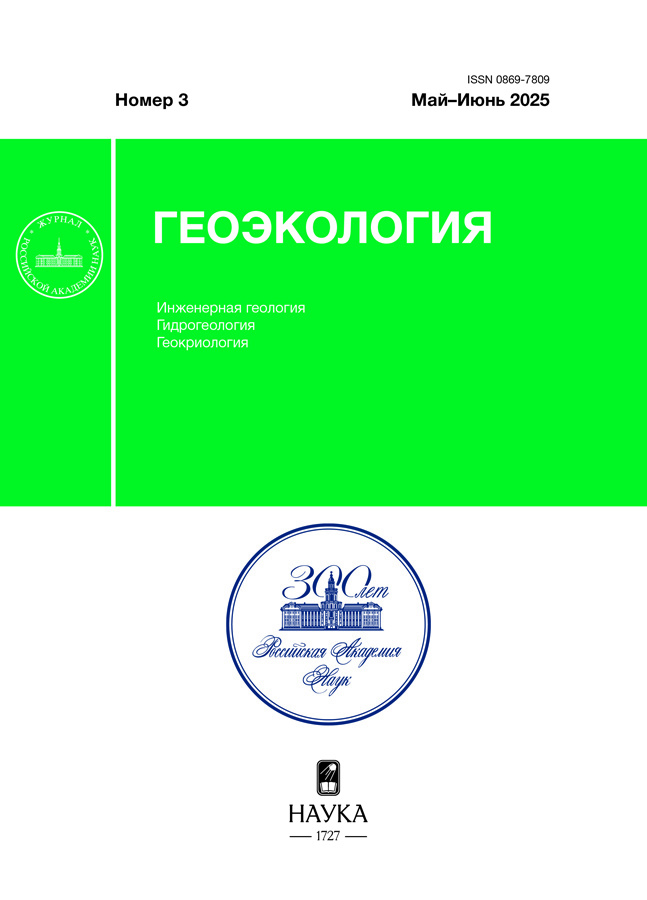Environmental Geoscience
ISSN (print): 0869-7809
Founders: E.M. Sergeev Institute of Geoecology of the Russian Academy of Sciences, Russian Academy of Sciences
Editor-in-Chief: Voznesensky Evgeny Arnoldovich, Doctor of Geological and Mineralogical Sciences
Frequency / Access: 6 issues per year / Subscription
Included in: White List (3rd level), Higher Attestation Commission List, RISC
Media registration certificate: No. 0110144 dated 02/04/1993
Geoekologiya is a journal dealing with the fundamental and applied aspects of today’s most urgent issue—human-induced changes in the geoenvironment. Its principal objective is the effective solution of geoenvironmental problems involving conservation of the environment, development of its potential, and the improvement of human living conditions. The topics of the papers are:
- environmental changes under the effect of anthropogenic factors;
- contamination of ground and surface waters, soils, and rocks;
- degradation of natural landscapes;
- the theory and methods of monitoring and prediction of natural and human-induced hazardous processes;
- geodynamic, seismic, and geoengineering regionalization of terrain;
- stability of urban areas and industrial agglomerations;
- utilization of industrial and domestic wastes;
- planning and use of land and subsurface space;
- the location and construction of facilities hazardous to the environment;
- accident-proof functioning of natural and engineering systems (dams, nuclear power plants, irrigation systems, and major industrial facilities);
- geoenvironmental problems of safe underground disposal of radioactive and other environmentally hazardous wastes;
- geoenvironmental problems of development of mineral deposits;
- recovery of mining wastes;
- remediation of contaminated terrain;
- support for an environmentally sound policy of utilization of mineral resources and managerial decisions for sustainable development;
- geoenvironmental conditions and human health;
- application of novel technologies to studying geoenvironmental problems.
The papers written by scientists from Russia and other countries are intended for specialists in natural sciences engaged in research, education, engineering survey, and production.
The distinguishing feature of the journal is a profound scientific analysis of a wide range of acute geoenvironmental problems and the search for efficient practical solutions for the environment conservation and sustainable development of society. The journal publishes papers written by leading Russian and foreign scientists.
Ағымдағы шығарылым
№ 3 (2025)
Articles
THE LATEST NEOTECTONIC STRUCTURES IN THE EASTERN DAGESTAN
Аннотация
 3–18
3–18


MODELS IN ENGINEERING GEOLOGY AND HYDROGEOLOGY
NUMERICAL MODELING OF FILTRATIONAL WATER EXCHANGE WITHIN POORLY DRAINED WATERSHEDS OF LESNAYA AND MUKHAVETS RIVERS (BELARUS)
Аннотация
 19–37
19–37


SOIL AND ROCK ENGINEERING AND MECHANICS
PECULIARITIES OF HIGHER PLANT RESPONSE TO HYDROCARBON CONTAMINATION IN SANDY SOIL UPON PHYTOTESTING
Аннотация
 38–47
38–47


ENVIRONMENT CONTAMINATION
GEOECOLOGICAL PROBLEMS OF THE KHOLBOLDZHINSKOE BROWN COAL DEPOSIT DEVELOPMENT
Аннотация
 48–61
48–61


ORGANIC MICROCOMPONENTS OF WATER AND APPLIED ASPECTS OF ASSESSING THEIR CHANGES UPON STORAGE IN PET PACKAGING
Аннотация
 62-72
62-72


UTILIZATION AND DISPOSAL OF WASTE
DIOXINS AND OTHER PERSISTENT ORGANIC POLLUTANTS IN RESIDUE OF SOLID MUNICIPAL WASTE INCINERATION: TYPES, CONTENTS, FORMATION, AND DETOXIFICATION
Аннотация
 73–85
73–85


RESEARCH METHODS AND TECHNIQUES
STUDY OF SOIL COMPOSITION INDICATORS BASED ON HYPERSPECTRAL SURVEY DATA
Аннотация
The article discusses modern technologies for assessing soil composition indicators based on hyperspectral satellite survey data, and critically analyzes the possibility of using hyperspectral data to improve the informativeness of engineering geological studies. The features of available hyperspectral data and processing algorithms are reviewed. The main limitations related to the influence of vegetation cover, terrain, and spatial resolution are indicated. It is shown that, considering existing constraints and features, hyperspectral data can be used to estimate soil moisture, organic matter content, and mineral and granulometric composition. The necessity of developing a domestic soil spectral library linked to GOST 25100 and adapting processing algorithms to national standards is emphasized.
 86–100
86–100












